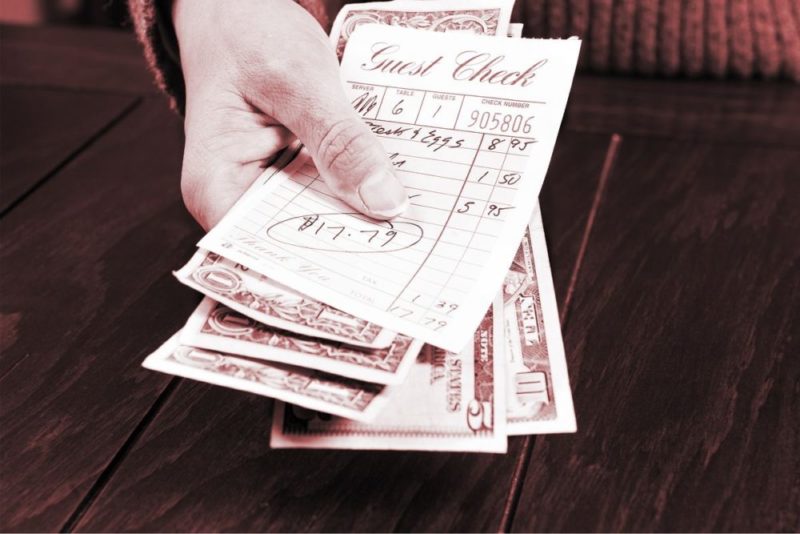The reports of the death of tipping in America have been greatly exaggerated. Last week, one of the most visible advocates of eliminating tipping, Danny Meyer of the Union Square Hospitality Group, unexpectedly revealed that he was abandoning his “hospitality included” model across all of his company’s full-service restaurants.
When he announced the initiative in 2015, Meyer was championed for having the courage to repair the broken economics of restaurant labor. As it turns out, eradicating tipping isn’t as simple as flipping a switch in the payroll fuse box. Try to imagine what would happen in your office if management announced one morning that everyone’s salary was being recalculated without any change in aggregate pay. Everyone would revolt, except the ones getting raises. That’s more or less what happened at USHG.
In arguing for change, Meyer and others have cited the racist history of tipping in America. When slavery was abolished, the tipping system became a backhanded way for white business owners to avoid paying fair wages to recently freed slaves, if they even paid them at all.
As America continues its long overdue reckoning with racial divisions through the Black Lives Matter movement, more evidence mounts that tipped minimum wages reinforce the income disparities that disproportionately affect communities of color. A recent report by One Fair Wage, an organization dedicated to ending sub-minimum hourly wages for tipped workers, explicitly details how women and communities of color have been systematically shortchanged when tips are the primary source of their income.
What often isn’t acknowledged in the controversy is how tipping is promulgated by free-market capitalism and sustained by conservative fiscal ideology. Over time, tipping has evolved into a renewable cycle of gladhanding that exists mainly to benefit white people. For too long, the hospitality industry has levered its own survival to the wealth of its patrons. Prior to the onset of COVID-19, prices at high-end restaurants had reached astronomical levels, and yet there was no shortage of buyers. The restaurant industry has always been the perfect dance partner for privilege.

As with other capitalist endeavors, the rules of engagement in restaurants are shaped by money. Upscale restaurants have become meritocracies. Order an expensive bottle of wine and your meal won’t be rushed; have an appetizer as your entree and your check will arrive before you ask for it.
Affluent guests learn quickly how having money can curry favor—fast tracking reservations, ensuring preferred seating arrangements and facilitating complimentary items. Tipping has become a natural extension of that moneyed dynamic. The promise of a gracious tip keeps the servers’ interests aligned with the owners’—to extract as much money as possible from their most valuable guests.
The blameless environment of a restaurant makes rich people feel powerful. Regulars become codependent on the false affection money affords and servers are lured in by the handsome sums they receive in exchange for manufacturing concern. Once both sides get hooked up to the drip, it’s difficult to kick the habit. Of course, both parties are equally irritated when these capitalist forces turn against them. Servers seethe when they’re tipped poorly without proper cause. Parties with reservations waiting at the bar bristle when a group of regulars tips the maître d’ and is whisked immediately to their table ahead of them.
Market forces also dictate the supply of qualified labor. Tipped employees choose jobs based on their economic best interests. All things being equal, if a restaurant is busy and management has devised a system to facilitate its staff making good money, it will attract talent and staff will be loyal. If a restaurant isn’t consistently busy or the system of distributing tips is ill-conceived, retention will suffer. If restaurateurs want to attract and retain qualified labor, they must find a formula that keeps wages competitive with the market. Danny and USHG learned this lesson the hard way.
Of course there have been many restauranteurs that have successfully implemented non-tipping models, but in general those experiments have occurred on a much smaller scale. Fostering the necessary trust and a sense of shared responsibility is a harder sell for larger restaurant groups.
We see the same tensions infecting our national politics. Shared wealth has struggled to be embraced as a mainstream political idea. You don’t have to look very far to see the unsuccessful attempts of progressive leaders like Bernie Sanders and Elizabeth Warren to center socialism as the dominant ideology of the Democratic Party. Republicans, on the other hand, spend most of their energy vilifying anything related to the notion of collective prosperity.
Just as many independent restaurants have successfully eliminated tipping on a local level, a new generation of politicians like Alexandria Ocasio-Cortez, Rashida Tlaib and Ilhan Omar have burst onto the national scene with a socialist message that mirrors the changes in political attitudes in their home districts. This dichotomy suggests that changing the tipping system with the mindset of grass-roots community organizers might be more effective than a top-down approach that relies heavily on proselytizing and PR spin.

At the end of the day, this isn’t a problem unique to the restaurant business, it’s a contradiction at the heart of the American ethos. E Pluribus Unum is E Pluribus Over. The disunion and moral decay began long before Trumpism, but the current political climate exacerbates the wealth gap between the winners and losers. Making America “Great Again” requires removing any barriers that impede one’s acquisition of personal wealth. To free-market capitalists, rewarding the resourcefulness of a convincing server with a commission of his or her sales drives both revenue for the restaurant and income growth for the server.
The problem is that capitalism can’t be bothered by the hardship that besets the people it leaves behind. Free markets must have winners and losers. It’s part of the game; The Art of the Deal, if you will. In our ruthless quest to amass capital, Americans view coming out on the losing end as a sign of personal weakness. But it isn’t fair to measure the aptitude of the players on a playing field that isn’t level.
Americans have a gift for deluding themselves into thinking that everyone is given a fair shake. The conservative pundits who want to scale back federal stimulus during the pandemic, for example, are convinced that we should all pull ourselves up by our bootstraps. Unfortunately, not everyone’s boots have straps. Some people are barefoot.
The tipping system won’t go away until America is ready to face its demons. In most fine dining establishments around the country little has changed through the decades—the kitchens are filled with underpaid Black and brown people while the staff of most dining rooms are well-paid and overwhelmingly white. Other thriving industries like finance, technology, medicine and law systematically exclude communities of color from the prosperity they generate. Those industries, in turn, perpetuate a cycle of transferring wealth to high-end restaurants where white owners and white servers are the primary beneficiaries.
To eliminate tipping, we must first dismantle white supremacy by demanding equitable pay and an end to racial discrimination and gender bias. To do so means we have to care about each other first—a seemingly insurmountable task in America today. Deaths from the Coronavirus continue to reach nightmarish levels, conspiracy theories flourish, politicians point fingers and Karens throw daily tantrums at Trader Joe’s about wearing masks in public. For a country founded on Christian values, it’s clear that loving thy neighbor isn’t exactly our strong suit.


